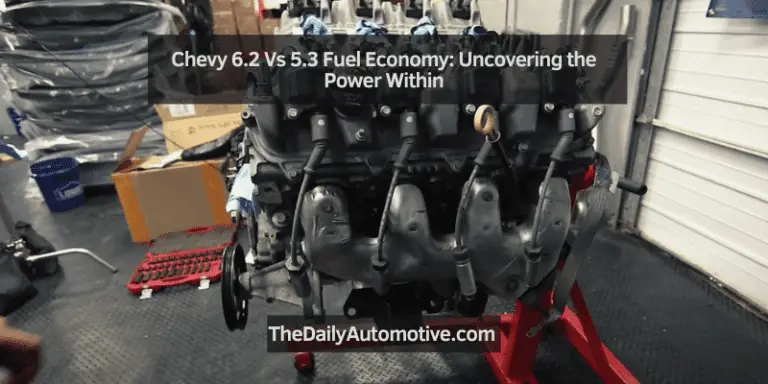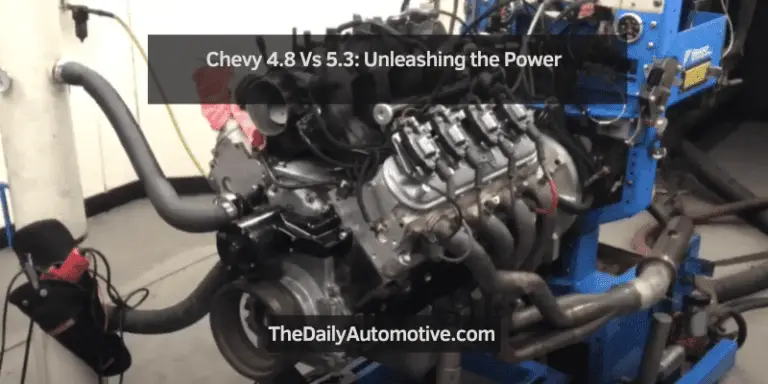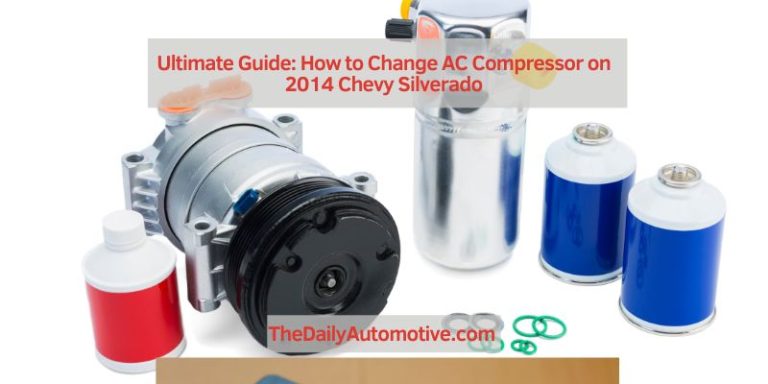How Does the Chevy V8 to V4 Work: Unraveling the Ingenious Engine Switch
The Chevy V8 to V4 works by using active fuel management (AFM) to disable four of the eight cylinders during light-load driving conditions, improving fuel efficiency while maintaining performance. This technology allows the engine to seamlessly switch between V8 and V4 modes based on the driver’s demands, optimizing fuel consumption and reducing emissions.
The Chevy V8 to V4 technology revolutionizes the way engines function by effectively balancing power and efficiency. By implementing active fuel management (AFM), Chevrolet has been able to enhance the performance of their V8 engines while also improving fuel economy.
This innovative system intelligently disables four of the eight cylinders during low-load driving situations, such as highway cruising, where full power output is not necessary. By doing so, it reduces fuel consumption and minimizes emissions without compromising on performance. We will explore the workings of the Chevy V8 to V4 system and delve into its benefits in terms of both performance and environmental impact.
Understanding The Chevy V8 Engine
The Chevy V8 engine’s V8 to V4 system operates by deactivating cylinders, resulting in improved fuel efficiency without sacrificing power. This innovative technology seamlessly transitions the engine from eight cylinders to four, optimizing performance and saving on fuel consumption.
The Chevy V8 engine is an iconic powerhouse that has been dominating the automobile industry for decades. With its robust performance and impressive capabilities, the V8 engine has become a symbol of power and speed. In this section, we will delve into the inner workings of the Chevy V8 engine, exploring its history, components, and the performance advantages it offers.
Brief History Of Chevy V8 Engines
Chevrolet has a rich history when it comes to V8 engines. The development of the first Chevrolet V8 engine can be traced back to the 1910s. Initially, these engines were quite small, but over the years, Chevrolet engineers pushed the boundaries and brought bigger and more powerful V8 engines to the market. Today, Chevy V8 engines are available in various displacements, ranging from 5.3L to 6.2L, offering a wide range of power options to suit different needs and preferences.
Explanation Of V8 Engine Components
The Chevy V8 engine is a marvel of engineering, comprised of several crucial components that work harmoniously to deliver unprecedented power. Let’s take a closer look at these components:
Cylinder Block: The foundation of the V8 engine, the cylinder block houses the cylinders where the combustion process takes place. It is typically made of strong cast iron or aluminum to ensure durability and efficient heat dissipation.
Pistons: The pistons move up and down within the cylinders, driven by the force generated from the burning of fuel and air mixture. They are connected to the crankshaft through connecting rods, and their movement creates the rotational motion necessary for the engine to function.
Crankshaft: The crankshaft is responsible for converting the reciprocating motion of the pistons into rotary motion that drives the wheels. It is a precision balanced and strategically designed component that ensures smooth operation and power delivery.
Camshaft: The camshaft controls the opening and closing of the engine’s valves, allowing the intake of fuel-air mixture and the expulsion of exhaust gases. It is driven by the crankshaft via a timing belt or chain, ensuring precise timing and efficient combustion.
Performance Advantages Of V8 Engines
The Chevy V8 engine is renowned for its exceptional performance, and for good reason. Here are some of the advantages that V8 engines bring to the table:
- Power: V8 engines are known for their impressive power output. The V8 configuration offers eight cylinders, providing greater displacement and an increased number of power strokes per revolution. This results in enhanced acceleratio” can occupy an entire lane.
- Torque: Torque is the twisting force generated by the engine, and V8 engines are known for their abundant torque. This allows vehicles equipped with V8 engines to easily tow heavy loads and conquer steep inclines without breaking a sweat.
- Smoothness: The evenly spaced firing intervals of the V8 engine contribute to its smooth operation. With four cylinders firing at the same time on each bank, the power delivery is continuous and refined, ensuring a comfortable driving experience.
- Sound: The deep and throaty exhaust note of a V8 engine is music to the ears of many automotive enthusiasts. The combination of multiple cylinders firing in unison creates a distinctive sound that is often associated with power and performance.
- Flexibility: V8 engines are versatile powerplants that can be tuned for various applications. Whether it’s a high-performance sports car or a rugged truck, the V8 engine offers the flexibility to cater to different driving needs and preferences.
In conclusion, the Chevy V8 engine is a true marvel of engineering, delivering exceptional power, torque, and smoothness. With its rich history, intricate components, and performance advantages, it’s no wonder that the V8 engine continues to dominate the automotive landscape. Whether you’re a gearhead or simply appreciate the exhilaration of driving, the Chevy V8 engine is sure to impress.
The V8 To V4 Engine Switch
The Chevy V8 to V4 engine switch operates by seamlessly transitioning between eight and four cylinders for improved fuel efficiency and performance. This technology optimizes power delivery while reducing fuel consumption, making it an efficient choice for Chevy enthusiasts.
Introduction To Chevy’s Active Fuel Management (afm) System
When it comes to fuel efficiency, Chevy has introduced a groundbreaking technology called Active Fuel Management (AFM) system. This system allows Chevy V8 engines to operate in both V8 and V4 modes, optimizing fuel consumption without compromising on power.
How Afm Switches Between V8 And V4 Modes
At the heart of the V8 to V4 engine switch lies Chevy’s innovative Active Fuel Management (AFM) system. This system, controlled by the engine’s computer, actively monitors various engine parameters such as throttle position, vehicle speed, and engine load.
When the power demand is low, such as during cruising or deceleration, the AFM system seamlessly transitions from V8 to V4 mode. This switch is made possible through the use of hydraulic lifters that allow the deactivation of four cylinders in the engine.
By deactivating four of the eight cylinders, the engine effectively switches to a more fuel-efficient V4 mode. This cylinder deactivation is achieved by closing the intake and exhaust valves of the dormant cylinders, eliminating combustion and reducing fuel consumption.
It’s important to note that this switch between V8 and V4 modes happens in real-time, almost imperceptibly to the driver. This allows for a smooth and seamless transition, ensuring a comfortable driving experience without any noticeable change in power or performance.
Benefits And Drawbacks Of The V8 To V4 Engine Switch
Benefits:
- Enhanced Fuel Efficiency: The V8 to V4 engine switch offered by Chevy’s Active Fuel Management (AFM) system significantly improves fuel efficiency, allowing drivers to save money at the pump.
- Reduced Emissions: By operating in V4 mode during light load conditions, the engine produces fewer emissions, contributing to a cleaner and greener environment.
- Seamless Transition: The V8 to V4 engine switch happens seamlessly, providing drivers with a smooth and uninterrupted driving experience without compromising on power.
Drawbacks:
- Potential for Vibration: In some cases, the transition between V8 and V4 modes can lead to a slight vibration, although Chevy has implemented various measures to minimize this effect.
- Complexity and Maintenance: The AFM system adds complexity to the engine, which may require additional maintenance compared to non-AFM engines. Regular maintenance, such as oil changes, is crucial to ensure the smooth operation of the system.
Overall, the V8 to V4 engine switch offered by Chevy’s Active Fuel Management (AFM) system brings significant benefits in terms of fuel efficiency and reduced emissions. While there may be minor drawbacks such as potential vibration and additional maintenance, the advantages outweigh these considerations, making Chevy’s AFM system a valuable technology for drivers seeking both power and efficiency.
Conclusion
The Chevy V8 to V4 system is designed to optimize fuel efficiency without compromising power. By seamlessly switching between eight and four cylinders, the engine adjusts to the driving conditions, saving fuel in situations where less power is needed. This innovative technology is a testament to Chevy’s commitment to sustainability and providing a smoother and more economical driving experience.
Whether you’re cruising down the highway or tackling city traffic, the Chevy V8 to V4 system ensures you get the best of both worlds – power and efficiency. Upgrade your ride and enjoy the benefits of this advanced engine technology.








